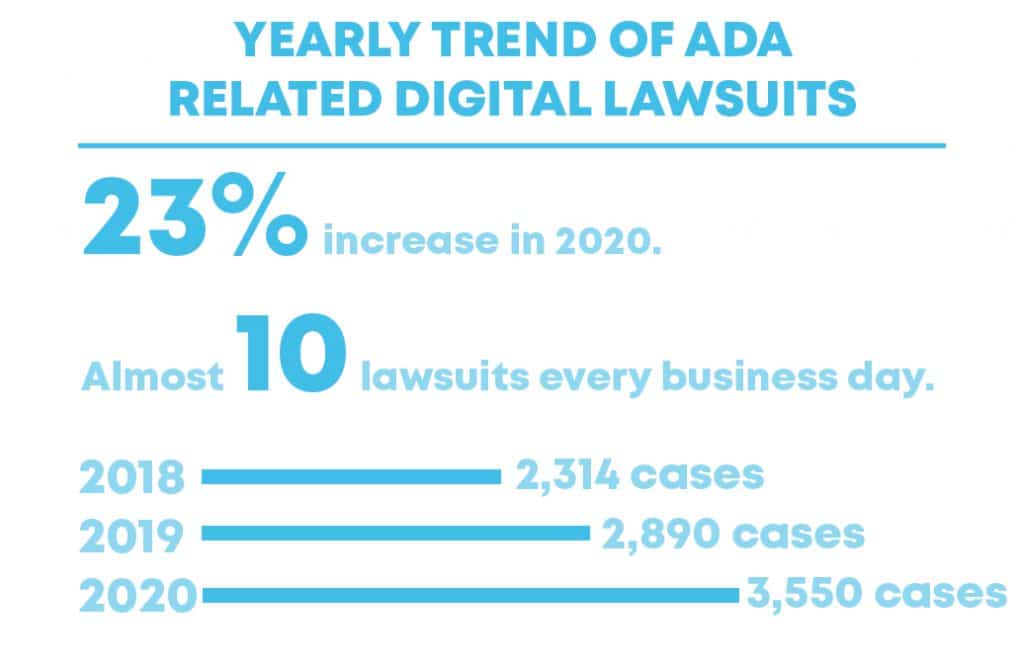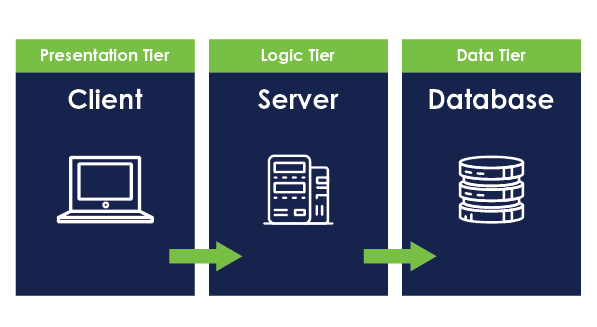Blue parking signs, gradual sloping ramps, and designated bathroom stalls are all familiar accessibility elements that we often encounter in brick-and-mortar businesses. However, when most of everyday life migrated online, we gained the responsibility to create a similarly inclusive experience with digital accessibility. And while pursuing accessibility online by empowering all users, you can achieve ROI by avoiding litigation and creating opportunities within the disabled community.
Reducing Legal Risk
The goal of digital accessibility can be overwhelming and even intimidating for those that are aware of its progressing legal implications. The Americans with Disabilities Act (ADA) has grown to consider online spaces as “places of public accommodation” and Section 508 specifically rules that the Federal government and organizations that commerce with it must be digitally accessible. Every year, ADA web lawsuit numbers are record-breaking. And considering Congress’s decision to not pass the Online Accessibility Act that attempted to restrict a plaintiff’s ability to sue—the numbers have no show of slowing.

Certain businesses are especially vulnerable. The top three industries involved in ADA web lawsuits in 2020 were Retail, Food Service, and Education. These industries possess intrinsic accessibility pitfalls that repeatedly earn them top spots throughout the years. Most retail and food-service applications have complex functionalities that without clear accessibility initiatives are completely inaccessible. For education, its explicit equality standard puts it under higher scrutiny. With the pandemic sending everyone online, these industries that are involved in day-to-day activities faced even more pressure.
It’s not only retail, food-service, and education that possess the previous characteristics. Any business that shares them has increased risk. Other variables to consider that increase risk are the following:
- Proportion of business carried out online – Is the only way to interact with your business online? An inaccessible application could completely exclude the disabled community from your business.
- User number – Are there a lot of people using your application? More users increases the likelihood of accessibility shortfalls manifesting.
- Current state of accessibility – How accessible is your application today? Having little to no access to your application is incredibly frustrating for users—the less accessible, the sooner you can expect repercussions.
Calculating ROI in Web Accessibility
Speaking of risk and future events requires us to think in terms of probability. Everything we’ve seen thus far has only been a factor to increase the probability of a lawsuit because no business is or will ever be invincible from being sued. The amount of risk a business holds is dependent on its probability of lawsuit multiplied by the expected loss (Karl Groves). This ‘expected loss’ used in the risk formula is the financial cost of a lawsuit; however, we should note that settlement isn’t the only potential loss. ADA web lawsuits are heavily publicized, and the reputation of exclusion is lasting.
For example, let’s imagine you are an average university or college. Your probability is very high, more than 50%. To calculate the expected loss, we use past cases as a reference point. A recent educational ADA web lawsuit against Harvard (due to the absence of closed captions) settled last year for over $1.5 million. Another similar case at MIT is estimated to settle for over $1 million. Taking the conservative side to both probability and expected loss, your estimated risk amount is $500,00 (.50 x 1,000,000). Therefore, a positive ROI can be obtained by spending up to $500,000 on accessibility training or consultants.
Though the high stakes of litigation have played a significant role in accessibility’s increased awareness and is a valid factor, businesses and users are being disadvantaged by only involving the law with accessibility. Digital accessibility’s purpose is to empower every person through technology. Focusing on its purpose elevates both accessibility’s full potential for users and return on investment for businesses past just litigation.
Increase Business Opportunities
Sixty million adults in the US have a disability. Not only are companies disadvantaging consumers, but they are jeopardizing business opportunities. Considering the disabilities that affect individuals who use technology independently, hearing and visually impaired make up 40% of this number. The percentage of the adult population that lives with a disability makes up an estimated $645 billion in spendable annual income. The magnitude of people in the American population that rely on web accessible features for business is often underestimated.
At the heart of creating an accessible application, is the motivation to make the most user friendly experience. This is true for every user—disabled or not. Countless applications suffer from general usability issues that are exposed through WCAG criteria. I’ve had my fair share of experiences with confusing form errors that have directly led me to abandoning the interaction with the site. Evaluating these sites relative to the WCAG would have easily failed, the simple but so crucial for all users, criteria of 3.3.1 Error Identification. Accessibility conversations are user experience conversations. Improving the usability of your application both increases your customer base and retains them overtime. Taking the initiative to truly cultivate an accessible ecosystem optimizes accessibility for everyone. This allows you to promote inclusion in your marketing, gain more customers, and mitigate risk. Treating accessibility as a checkbox or simply a liability is restricting. Instead, accessibility is an ecosystem that once interwoven with your business culture will continue to deliver results.
Be in the Know
Most businesses are unaware of how inaccessible their website is, how much of an impact it has on users, or how to even begin. Zirous is proud to partner with companies through this journey of understanding and creating accessible solutions. At Zirous, we believe accessibility is fundamental and everyone is responsible for making digital accessibility ubiquitous. Zirous can help you take that first step in making this a reality. Contact us for a free initial accessibility assessment today!
The information provided in this article is for general informational purpose only. It is not legal advice.




This Post Has 0 Comments